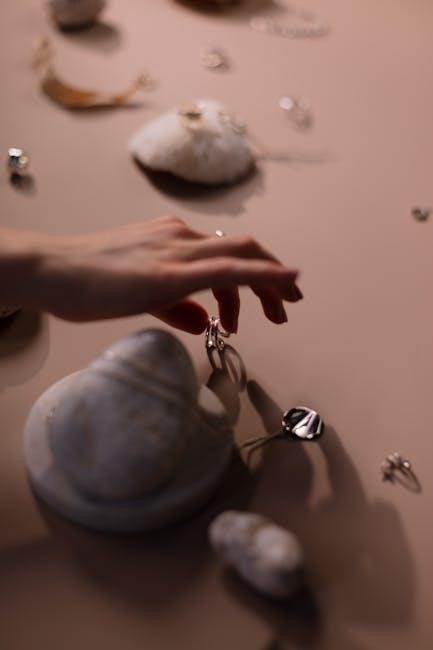O-rings are vital components in sealing applications, ensuring leak-tight connections in various industries․ Proper design is crucial for performance, durability, and reliability in engineering systems․
What is an O-Ring?
An O-ring is a circular, doughnut-shaped seal used to prevent the passage of liquids, gases, or other substances between two surfaces․ Typically made from elastomeric materials, such as rubber or synthetic polymers, O-rings are designed to be seated in a groove and compressed to create a tight seal․ Their circular cross-section allows them to deform under pressure, filling microscopic gaps and ensuring leak resistance; O-rings are widely used in various industries, including aerospace, automotive, and industrial manufacturing, due to their simplicity, effectiveness, and versatility․ They are essential components in hydraulic systems, pumps, and valves, where sealing integrity is critical․ The design and material selection of O-rings depend on the specific application, operating conditions, and required performance characteristics․
Importance of Proper O-Ring Design
Proper O-ring design is crucial for ensuring optimal sealing performance, preventing leaks, and maintaining the integrity of systems in various applications․ Correctly designed O-rings enhance durability, reduce the risk of premature failure, and minimize maintenance costs․ They also ensure compatibility with operating conditions, such as temperature, pressure, and chemical exposure, which are critical for reliable functionality․ Improper design can lead to seal failure, equipment damage, and safety hazards․ By considering factors like dimensions, materials, and environmental factors, proper O-ring design guarantees efficient and safe operation across industries, from aerospace to industrial manufacturing․ It also extends the lifespan of equipment and prevents costly downtime, making it a foundational element in engineering and system design․
Key Considerations in O-Ring Design
Dimensions, material compatibility, operating temperature, pressure, and chemical resistance are critical factors in O-ring design to ensure optimal sealing performance and durability in various applications․
Understanding O-Ring Groove Design
O-ring groove design involves precise calculations to ensure proper sealing․ The groove dimensions must accommodate the O-ring’s cross-section, ensuring the correct squeeze and compression for optimal performance․ Proper surface finish and geometry are critical to prevent leakage and wear․ Factors like material compatibility, operating conditions, and application specifics guide the design process․ Global standards and guidelines, such as those from Global O-Ring and Seal, provide foundational recommendations for groove depth, diameter, and surface finish․ These specifications help ensure the O-ring functions effectively under various pressures and temperatures, minimizing the risk of failure․ By adhering to these principles, engineers can design reliable and durable sealing solutions across industries․
Importance of Squeeze and Compression
Squeeze and compression are critical factors in O-ring performance․ Proper squeeze ensures the O-ring deforms to fill the groove, creating a tight seal․ Insufficient squeeze may lead to leakage, while excessive squeeze can cause premature wear․ Compression ensures the O-ring remains in contact with the mating surfaces, preventing gaps․ The ideal squeeze rate balances sealing effectiveness and longevity․ Factors like material elasticity, operating temperatures, and pressure influence the required compression levels․ Incorrect squeeze or compression can result in reduced service life or immediate failure․ Thus, precise calculation and adherence to design guidelines are essential to optimize sealing performance and durability in various applications․ This ensures reliable operation under diverse conditions․

Materials for O-Rings
O-rings are made from various elastomers like nitrile rubber (NBR), Viton, and EPDM․ Each material offers unique properties, such as resistance to chemicals, heat, or abrasion, ensuring optimal performance․
Common Elastomers Used in O-Ring Manufacturing
O-rings are typically manufactured from elastomers such as nitrile rubber (NBR), fluorocarbon (Viton), and ethylene propylene diene monomer (EPDM)․ NBR is widely used for general-purpose sealing due to its excellent resistance to oils, fuels, and abrasion․ Viton, on the other hand, offers superior resistance to high temperatures and aggressive chemicals, making it ideal for demanding industrial applications․ EPDM is known for its durability in steam and outdoor environments, providing excellent resistance to UV light and ozone․ Other materials, such as silicone (VMQ), are utilized for extreme temperature applications, while polytetrafluoroethylene (PTFE) is chosen for its exceptional chemical resistance․ Each elastomer is selected based on its specific properties to ensure optimal performance in diverse sealing environments․

Selection Criteria for O-Rings
Selecting the right o-ring involves considering dimensions, material compatibility, and operating conditions․ Key factors include temperature range, chemical resistance, and mechanical stress to ensure optimal performance and longevity․
How to Choose the Right O-Ring for Your Application
Selecting the appropriate o-ring involves a thorough evaluation of application-specific requirements․ Begin by determining the operating conditions, including temperature, pressure, and the nature of the fluids or gases involved․ Material compatibility is critical; for instance, nitrile rubber is suitable for hydrocarbons, while Viton is ideal for aggressive chemicals․ Next, consider the o-ring’s dimensions, ensuring they match the groove specifications to achieve proper sealing․ Mechanical stress, such as compression and stretch, should also be assessed to prevent deformation․ Additionally, consult industry standards or manufacturers’ guidelines to narrow down options․ Finally, testing the o-ring under simulated conditions can confirm its suitability, ensuring long-term reliability and performance in the application․
Applications of O-Rings
O-rings are essential in automotive, aerospace, and industrial applications, providing reliable sealing in engines, hydraulic systems, and pumps․ They also play a crucial role in consumer goods manufacturing․
Industrial Uses of O-Rings
O-rings are critical components in industrial applications, providing sealing solutions in harsh environments․ They are widely used in oil and gas, chemical processing, and manufacturing industries to prevent fluid and gas leaks․ In hydraulic and pneumatic systems, O-rings ensure reliable performance by maintaining pressure integrity․ They are also essential in pumps, valves, and cylinders, where consistent sealing is vital for operational efficiency․ The durability and resistance of O-rings make them ideal for high-temperature and high-pressure applications․ Additionally, they are used in rotating equipment and mechanical systems to prevent contamination and wear․ Their versatility and effectiveness in industrial settings highlight their importance in maintaining equipment reliability and operational safety across various sectors․
Custom Applications and Special Designs
Custom O-ring designs cater to unique industrial needs, offering tailored solutions for specific applications; Special designs include non-standard sizes, unusual materials, and unique cross-sections to meet particular sealing requirements․ These custom solutions are essential for industries with extreme operating conditions, such as aerospace and high-temperature manufacturing․ Custom compounds are developed to withstand aggressive chemicals or extreme temperatures, ensuring optimal performance․ Additionally, custom groove designs and specialized coatings can enhance sealing efficiency and longevity․ These tailored solutions enable equipment to function reliably in challenging environments, making custom O-ring designs indispensable for innovative and specialized applications where standard products fall short․ Their adaptability ensures they meet the precise demands of modern engineering challenges․
Challenges in O-Ring Design
O-ring design faces challenges like extreme temperatures, chemical resistance, and precise dimensional tolerances․ Balancing sealing performance with compression is critical to avoid failure in demanding applications․
Common Failure Modes and Solutions

Common failure modes in o-ring design include extrusion, abrasion, and chemical degradation․ Extrusion occurs when the o-ring is squeezed beyond its limits, causing material to escape․ Abrasion happens due to improper surface finishes or particles in the system․ Chemical degradation results from incompatibility with the operating medium․
- Extrusion: Solve by selecting the correct durometer and ensuring proper groove dimensions․
- Abrasion: Address by improving surface finish and using lubricants․
- Chemical Degradation: Mitigate by choosing materials compatible with the operating fluids․

Addressing these issues requires careful material selection, precise groove design, and proper application conditions to ensure long-term sealing performance․

Future Trends in O-Ring Technology

Advancements in materials and design are driving innovation, with a focus on new elastomers, improved sealing concepts, and eco-friendly solutions to meet demanding industrial requirements․
Advancements in Materials and Design
Recent advancements in materials and design are revolutionizing o-ring technology․ New elastomers offer enhanced resistance to extreme temperatures, chemicals, and wear․ Innovations in computational simulations enable precise modeling of sealing performance under various conditions․ Researchers are also exploring eco-friendly materials and self-healing polymers to improve sustainability and durability․ Designs now incorporate smart materials that adapt to environmental changes, ensuring optimal sealing․ These developments are driven by the need for higher reliability and longer service life in industrial applications․ As technology progresses, o-rings are becoming more efficient, versatile, and environmentally friendly, meeting the demands of modern engineering challenges․
